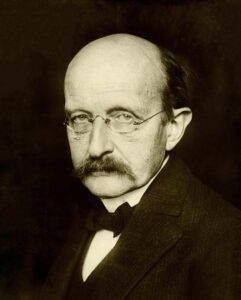Physics and Scripture
One of the most amazing developments during the last two centuries is the increasing agreement between physics and Scripture.
Unfortunately, this confirmation is known by most; it is hidden behind a so-called fight between religion and science assuming the two are contradictory.
Nothing could be further from the truth especially in three areas; physics, biology, and archaeology.
Prior to 150 years ago, there was little scientific confirmation of Scripture. The best scientists believed the universe was infinite in extent and age, and that the universe was stable meaning no expansion. The best scientists believed they had figured out everything about physics and all that needed to be worked out was the better calibration of physical constants.
Everything Important Had Been Discovered
Physicists of the 19th century believed everything important had been discovered. Maxwell Planck, who would later go on to make great discoveries in quantum physics, noted his advising professor Phillip von Jolly noted in 1878 that he should reconsider theoretical physics since there was not much left to be done.
More specifically, Max Planck in a 1924 lecture noted and further confirmed in the original German that,
When I began my physical studies and sought advice from my venerable teacher Philipp von Jolly … he portrayed to me physics as a highly developed, almost fully matured science … Possibly in one or another nook there would perhaps be a dust particle or a small bubble to be examined and classified, but the system as a whole stood there fairly secured, and theoretical physics approached visibly that degree of perfection which, for example, geometry had already for centuries.
Jolly was also not alone in this sentiment. Albert Michelson of the Michelson-Morley experiment fame noted in 1894 that,
It seems probable that most of the grand underlying principles have been firmly established and that further advances are to be sought chiefly in the rigorous application of these principles to all the phenomena which come under our notice. … An eminent physicist remarked that the future truths of physical science are to be looked for in the sixth place of decimals.
Lord Kelvin’s “Clouds”
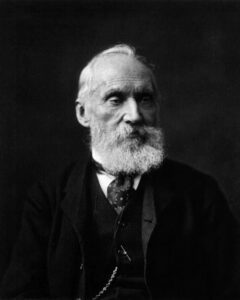
Lord Kelvin: By “Photo by Messrs. Dickinson, London, New Bond Street” (according to http://www.sil.si.edu/DigitalCollections/hst/scientific-identity/fullsize/SIL14-T002-07a.jpg) – http://www.sil.si.edu/digitalcollections/hst/scientific-identity/CF/by_scientist_display_results.cfm?scientist=kelvin, Public Domain, Link
This “eminent scientist” is thought to be Lord Kelvin who on April 27, 1900, gave his now infamous speech titled, “Nineteenth-Century Clouds Over the Dynamical Theory of Heat and Light.” In this speech, Kelvin noted,
“The beauty and clearness of the dynamical theory, which asserts heat and light to be modes of motion, is at present obscured by two clouds.
The two “clouds” to which Kelvin referred were,
- the inability to detect ether in the Michelson-Morley experiments, and
- the so-called ultraviolet catastrophe – the black body radiation effect.
We discuss the importance of the Michelson-Morley experiments in the finding there was no “ether” carrying light through the universe (analogous to sound waves carried by air). The ultraviolet catastrophe is the inability of classical physics to predict blackbody radiation explained here.
A blackbody radiator is similar to the stove element turning red when it gets hot. Red light is the predominant light given off as the coil heats, but there is also light at various other frequencies as well. The reason would be solved by Planck who formulated an equation utilizing quanta or discrete packets of energy with his now-famous Planck’s constant.
Interestingly, it would be Planck who was largely responsible for the initial development of quantum physics – a whole new field of physics that his supervising professor Dr. Jolly could not even contemplate.
Expansion of the Universe
The twentieth century would come with an explosion of knowledge concerning theoretical physics and the strange new world of quantum physics. In 1912, Vesto Slipher observed the light spectral lines of distant galaxies and compared them to nearer ones. He made a strange observation that they were all red-shifted – some more than others. This means all the distant galaxies were moving away from us at tremendous speeds.
This finding was generally ignored because it did not fit into the cosmology narrative at the time.

Edwin Hubble: By Johan Hagemeyer (1884-1962) – http://hdl.huntington.org/cdm/ref/collection/p15150coll2/id/129, Public Domain, Link
Edwin Hubble would make an observational discovery of these galaxies and discovered a general expansion of the universe. This means that the universe everywhere gives the appearance of traveling away from us at great velocities. He further noted that this recessional velocity increased with its distance from the Earth – now known as Hubble’s law. This law had been proposed by Georges Lemaitre two years previously.
Hubble is also responsible for noting the “clouds” observed by smaller telescopes were actually other galaxies outside our own. He was able to use Cepheid variable stars which had recently been discovered to help determine the distance to these other far-away galaxies. The stars pulse at a rate that is proportional to their absolute brightness enabling calculation of their distance.
He was able to see these Cepheid variable stars in distant galaxies and then calculate their distance. He was then able to combine the calculated distance to a galaxy with its velocity of recession away from us. He was then able to determine the so-called Hubble Constant that is still being fine-tuned today with various methods of calculation.
Hubble’s findings fundamentally changed the scientific view of the universe. Supporters noted that the discovery of galaxies outside of our own, and that all these galaxies are traveling away from us at tremendous speeds. Hubble himself was deeply troubled at his findings and generally did not believe them. He noted in a letter to Dutch cosmologist William de Sitter,
Mr. Humason and I are both deeply sensible of your gracious appreciations of the papers on velocities and distances of nebulae. We use the term “apparent” velocities to emphasize the empirical features of the correlation. The interpretation, we feel, should be left to you and the very few others who are competent to discuss the matter with authority.
Theological Implications of Expanding Universe
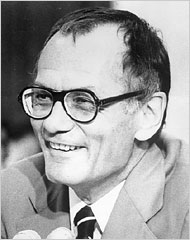
Robert Jastrow: George C. Marshall Institute
Many scientists were distressed by the implications of Hubble’s law. They were not so much distressed by the observed expansion, but by going back in time the derived contraction. His discoveries implied that at a distant past time, the entire universe was compressed to a single extremely small volume – what became known as a singularity.
Astrophysicist Robert Jastrow is one of those physicists who tried to make sense of his findings. He noted his training in physics was as a naturalist – no metaphysics or God allowed. In this regard, he viewed himself as an agnostic – that is, not knowing.
However, he did reservations concerning this belief noting,
The seed of everything that has happened in the Universe was planted in that first instant; every star, every planet and every living creature in the Universe came into being as a result of events that were set in motion in the moment of the cosmic explosion. It was literally the moment of Creation. … The Universe flashed into being, and we cannot find out what caused that to happen.
Jastrow later concluded,
For the scientist who has lived by his faith in the power of reason, the story ends like a bad dream. He has scaled the mountains of ignorance, he is about to conquer the highest peak; as he pulls himself over the final rock, he is greeted by a band of theologians who have been sitting there for centuries.
Eventually, he came to the conclusion that cosmology and Scripture are telling the same story,
Now we see how the astronomical evidence supports the Biblical view of the origin of the world. The details differ, but the essential elements in the astronomical and Biblical accounts of Genesis are the same: the chain of events leading to man commenced suddenly and sharply at a definite moment in time, in a flash of light and energy.
Scripture Claims for a Transcendent Beginning

Image by Free-Photos from Pixabay
As Jastrow intimates, scientists have been upstaged by Biblical personalities like Job, Moses, David, Isaiah, Jeremiah, and others. They have stated repeatedly and explicitly the two most significant features of the Big Bang – namely, a transcendent cosmic beginning a finite time ago, and a universe undergoing expansion.
For example, Isaiah 42:5 notes both properties,
This is what God the Lord says – the Creator of the heavens who stretches them out…”
The Hebrew word translated from Isaiah is “bara” which is Strong’s word 1254. Strong’s Hebrew and Aramaic Dictionary expounds upon the theological meaning of this verb. They note,
the verb expresses creation out of nothing, an idea seen clearly in passages having to do with creation on a cosmic scale. … All other verbs for “creating” allow a much broader range of meaning; they have both divine and human subjects and are used in contexts when bringing something or someone into existence is not the issue.
The issue is made even more explicit in the New Testament in Hebrews 11:3,
By faith we understand the world to have been framed by the word of God, so that the things seen should not come into being out of things that appear.
Scripture is very clear in both Testaments that God created all that is in beginning out of nothing.
God Stretched Out the Heavens
Scripture states very clearly on multiple occasions that God “stretched out” the heavens. Give different Bible authors wrote such statements in eleven different verses: Job 9:8, Psalm 104:2, Isaiah 40:22, 42:5, 44:24, 45:12, 48:13, 51:13, Jeremiah 10:12, 51:15, and Zechariah 12:1.
Furthermore, three of these verses make it clear that God alone is responsible for this “stretching” – Job 9:8, Isaiah 44:24, and 45:12.
The verbs also suggest that this “stretching” is an ongoing event. In cosmology, the Big Bang creation event was so precise so that all the physics produced (especially the laws, constants, and equations of physics) were such that there would be an ongoing, continual expansion of the universe at exactly the precise rates so that life would be possible.
Biblical Claims of Cosmic Cooling

Decay – Image by Eric Simon from Pixabay
One of the inferences made by cosmic expansion is that the universe is cooling. It is now 2.73 Kelvin or -454.75 degrees Fahrenheit. The laws of physics were set at the time of creation, and these laws operate throughout the universe since the creation event.
Jeremiah 33 shows God using the fixity of the physical laws as an analogy regarding his never-changing characteristics.
this is what the Lord says; If I do not keep My covenant with the day and with the night and fail to establish the fixed order of heaven and earth, then I might also reject the seed of Jacob and of my servant David.
The laws of thermodynamics are represented in Scripture as well. Romans 8:20 tell us that the entire creation has been subjected to “frustration” or “futility”. Furthermore, creation currently exists in a state of “slavery to decay” and “bondage to corruption.”
Ecclesiastes 1 and Revelations 21 support the concept that the whole universe suffers from this progressive decay. Progressive decay, disorganization, and cooling illustrate the second law of thermodynamics. As time progresses, the universe becomes progressively more disordered and run down.
Characteristics of the Big Bang Supported by Scripture
Far from being a theory that runs counter to Scripture, the Big Bang creation event is described in scripture.
There are three fundamental characteristics describing the big bang:
- a transcendent cosmic beginning that occurred at a point in time,
- a continuous universal cosmic expansion that is currently ongoing,
- cosmic cooling and progressive decay from an initial very hot state.
All three of these characteristics were explicitly taught in Scripture thousands of years ago before scientists discovered then over the past 150 years.
Moreover, the Bible along among all the Scriptures of the world is the only one that expounds these three fundamental characteristics of the creation event.
Therefore, scientific proofs of the Big Bang (and relativity which supports the Big Bang creation) simultaneously establishes the existence of God and the accuracy of Scripture in describing the creation event.
The theological implications of the Big Bang creation event as supported by Scripture is an affront to many secular skeptics believing in naturalism only. Those who reject the reality of God find such an idea repugnant and an affront to their world view.
There has been zeal for trying to find a way around such conclusions. Very imaginative theories have come and gone attempting to disprove the Big Bang creation event. Some of these include “imaginary time” proposed by Stephen Hawking or the creation of the universe out of “nothing that is something” according to Krauss.
The Controlled “Bang”
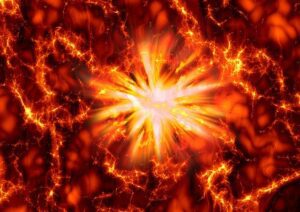
The Big Bang – Image by Gerd Altmann from Pixabay
The Big Bang is not an explosion as envisioned by most people. An explosion produces nothing but chaos with results that can not be precisely predicted.
However, the Big Bang is nothing if it is not precisely controlled. In fact, the big bang seems to be a carefully controlled release of matter, energy, space, and time within the confines of physical constants and parameters in order to make matter and life possible.
As the universe expands, it cools. If you could have an idea of the initial temperature, then it would be possible to calculate the current universe temperature.
George Gamow in 1948 calculated the initial temperature of the universe determined by nuclear physics. According to the hot Big Bang model, all the hydrogen and helium produced in the early universe (before stars) were produced in the Big Bang. Knowing the relative amounts of these elements, it is possible to calculate the temperature at their formation.
Using this knowledge, Gamow and associates calculated the temperature of the universe today should be about 5 degrees above absolute zero. This would be the temperature everywhere away from heat-generating objects like stars.
Finding the Cosmic Background Radiation
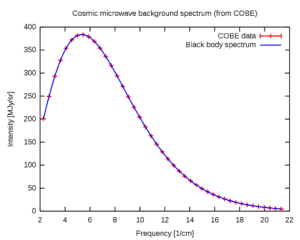
Cosmic Background Spectrum from COBE: By Quantum Doughnut – Own work, Public Domain, Link
In 1964, Arno Penzias and Robert Wilson put together an instrument that successfully measured the cosmic microwave background radiation (heat) at about 3 degrees Kelvin. Over the past few decades, it has been measured progressively more accurately.
Since the atmosphere interferes with these measurements, a satellite would be required for more accurate measurements of the background radiation. The COBE satellite in 1990 showed that the universe was like a perfect blackbody radiator dissipating all its available energy. There were no irregularities in the temperature greater than one part in ten-thousand.
This finding ruled out many other competing theories as to the beginning of the universe and secured the Big Bang model as the most accurate.
Entropy
Measurements of the cosmic background radiation show it fits very closely with a perfect radiator. This means the universe had an enormous degradation of energy which is called entropy. We can quantify the entropy of the universe at the time of the Big Bang in terms of a constant (Boltzmann’s constant) kB. The entropy of the universe at the time of the big bang was 10^88kB while now it is 10^103kB.
Such a high specific entropy is required to produce the elements required for life, and if there were any different from no stars or planets would have existed at any time.
Cosmic Background Radiation Irregularities
Irregularities in the cosmic background radiation are required yet the first COBE satellite did not have sensitive enough instrumentation to measure them. Subsequent more sensitive instruments now measured these irregularities to be about one part per hundred-thousand – just where theoretical physicists predicted.
However, some physicists thought this might be just random noise. Balloon instrumentation measured at least four different wavelengths and showed temperature fluctuations lining up perfectly with the COBE maps. Edward Cheng who was leader of the experiment, noted,
With two totally different systems, it’s very unlikely that random noise would give rise to the same lumps at the same places in the sky.”
Further investigations demonstrated actual structure within the cosmic background radiation. This structure would allow more conclusions to be derived from the radiation concerning universe origins.
Cosmic Background Radiation Show Hotter Universe in the Past
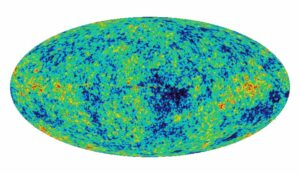
Cosmic Background Radiation.
When you look into the dark sky and see stars, you are actually looking years into the past. Stars are light-years away from us, meaning the light from stars takes years to get to Earth. The nearest star is about four light-years away while other visible stars with the naked eye are hundreds or even thousands of light-years away.
Gas clouds that are many millions of light-years away have spectral lines of carbon which allow their temperature to be measured. The Keck telescope is a huge eye into the Universe which allowed measurements of this spectrum at a time when the Universe was about one-fourth its current age.
According to the hog big bang model, the background radiation for the universe at this early time was calculated to be 7.58 K – now are measured at 7.4 plus or minus 0.8 K. David Meyer from Northwestern University noted these measurements are,
strikingly consistent with the Big Bang theory.
A few years later, these astronomers measured the carbon spectral lines in a more distant gas cloud. These measurements duplicating their earlier success. Another team did the same measurements at a much greater distance. These measurements showed a temperature of about 10 degrees K when the universe was one-sixth its current age.
All these measurements are very consistent with a hot Big Bang creation event.
Conclusion Concerning Physics and Scripture
Cosmology has learned much during the last hundred years concerning the origin of the universe. Cosmologists now know how hot it was, how fast it expanded, and its temperature at various ages.
We also know much about the structure of the universe and how galaxies and star systems came to be.
Scientists have a firm grasp on nuclear physics and how the stars shine. They also understand how the elements were made within stars and other places. More recent advances in cosmology include the discovery of gravitational waves produced by collisions of black holes and neutron stars.
These show the reality of a Big Bang creation event with each passing year. There seems to be little doubt that such an event occurred consistent with the Biblical narrative.
There is no reason to believe that further advances in cosmology will not continue to advance. This advancement will increase our understanding of the universe and continue to prove the Biblical narrative.

